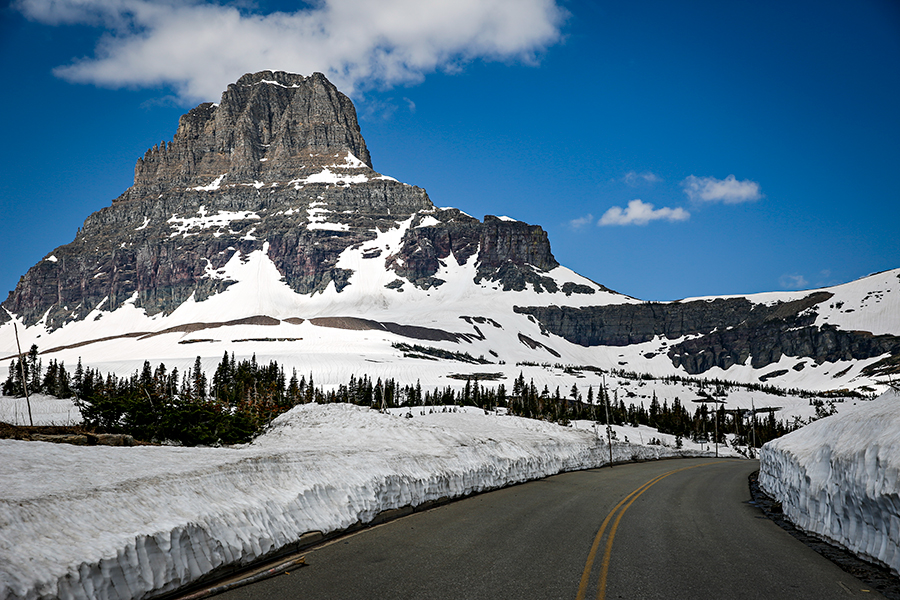What’s Next for the Sun Road?
After more than a decade of work, the Going-to-the-Sun Road restoration project is complete
By Justin Franz
The Going-to-the-Sun Road looked a whole different than it does today when Jim Foster first arrived in Glacier National Park in 2003.
After being open for 70 years — and being battered by 70 Montana winters — the legendary alpine highway was in rough shape, said Foster, who at the time was a park engineer before becoming chief of facility management in 2009. There were potholes all along the 50-mile highway, deteriorating culverts and numerous types of guardrails and retaining walls in various states of disrepair.
“It was pretty rough looking,” Foster said last week. “It’s a totally different road than when I first came the park in 2003.”
But those days are long gone after Glacier National Park and HK Contractors, Inc. recently completed a decade-long, $170 million rehabilitation of the Sun Road from Apgar to St. Mary.
Construction on the Sun Road began in the 1920s and it opened to traffic on July 15, 1933. Engineers originally planned for the road to climb to Logan Pass utilizing a series of tight switch backs, but National Park Service Director Stephen Mather thought that more direct route would miss some of the park’s most spectacular scenery (and thus miss the point of building the road in the first place). Mather, with the assistance of landscape architect Thomas Vint, conceived a more spectacular route along the rugged cliffs known as the Garden Wall.
The road is frequently hailed as one of the most spectacular drives in America and is on the National Register of Historic Places and a National Historic Civil Engineering Landmark.
Foster said the Park Service began addressing some of the problems with the Sun Road back in the 1990s, but it wasn’t until the mid-2000s that a complete and total rebuild of the entire road began. In 2007, the park hired HK Contractors, a contractor based in Idaho Falls with experience working on park roads, to complete a total rebuild. The project called for restoring retaining walls and culverts and repaving all 50 miles of road. Foster said the Park Service originally thought about shutting down the road for two or three years so that contractors could finish the rebuild done as soon as possible, but local businesses protested that idea, worried it would depress summer visitation. The decision was made to keep the road open during the entire project. That decision also meant the project would take more than a decade.
Don Herne, project manager for HK Contractors, said dealing with traffic was one of the hardest parts of the project, especially in the tight alpine section. While contractors would close one lane on certain segments, they were not able to work without interruption. Workers would often need to use both lanes of the road to move equipment around and Herne said sometimes they would only get to work for 10 or 15 minutes an hour before having to wait for another line of cars to go by. At the peak of the project, in 2011 and 2012, nearly 200 people were working on the road day and night during the summer.
“It was a really fulfilling project,” Herne said. “Not a lot of people can put a project like that on your resume.”
Earlier this summer, the Park Service and HK Contractors had a celebration to mark the end of construction. But just because the major rehabilitation of the road is over doesn’t mean there isn’t work to be done, Foster said. This year, the park is doing a pavement preservation project on the Sun Road that may require it to be closed between Avalanche Creek and Logan Pass in late September. Foster said it’s a small price to pay to ensure the road lasts for years to come.
“This was a $170 million taxpayer investment and so we have to protect it,” he said.
The park annually spends about $700,000 to keep the road open; that includes plowing the highway, installing and removing guard rails in the spring and fall (avalanche prone areas have removable guard rails) and having employees clear rocks from the roadway. That figure does not include major repairs.
In 2017, the park received a $75,000 Durapatcher from the Glacier National Park Conservancy. That piece of equipment can quickly patch potholes anywhere on the road.
“It lets us fix the road very quickly,” Foster said. “You can put a patch down and have the road open in 20 minutes.”
Amid increasing visitation, the park is also examining how visitors will be able to use the road in the future. The park is currently finishing a corridor management plan for the Sun Road. In the past, officials have said the management plan would look at numerous options to reduce congestion, including increasing shuttle services and possibly a reservation system for private vehicle access. A spokesperson for the park said they hope to release the final version of that plan this year.